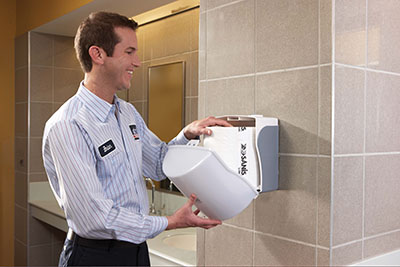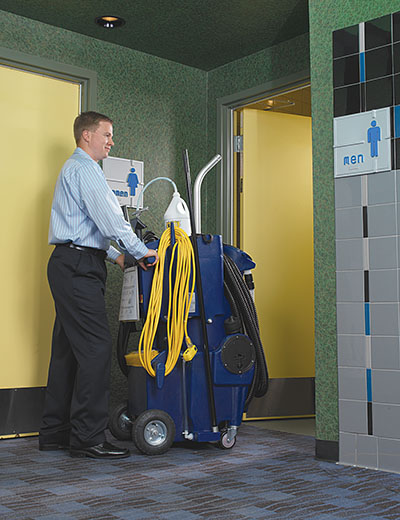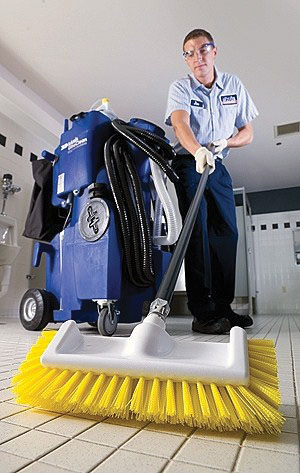Simple strategies to improve the appearance and cleanliness of your restrooms.
Sure, you have a restroom program in place where staff members regularly attend to the restroom and keep it clean, but do you have what it takes to become “America’s Best Restroom?” Every year, we receive hundreds of nominations from businesses looking to take home the trophy, but only one is selected. Past winners have included restaurants, hotels, theatres and airports. While the types of businesses run the gamut, one thing is consistent — each establishment has a rigorous program dedicated to ensuring the cleanliness of its restrooms.
“We have a five-step cleaning program that takes place every hour in each of our restrooms,” says Willie Porter, director of housekeeping operations at the Chicago Field Museum, the 2011 America’s Best Restroom award winner. “It’s something that our staff members learn as soon as they are hired and retested on each August to ensure they know they’re the right steps.”
Your restroom reflects your brand. A recent survey revealed that 95% of people would avoid an establishment if they found the restroom to be dirty. Moreover, 50% of building complaints concern restroom upkeep.
Restrooms are the most visited area in any facility, so it’s not shocking that they generate the most complaints. However, these statistics confirm that clean restrooms should be a top business priority. Customers remember unpleasant restroom experiences, and it makes them unlikely to return to or recommend a business to others. Or worse, they share their negative experience with others, potentially creating a wave of negative publicity through word of mouth, on online forums or social networking sites.
 Even the most pristine facilities can be negatively perceived if the restrooms are not maintained to a desired standard. To keep customers satisfied and returning, businesses must continuously invest time and resources to provide a clean and pleasant restroom experience. With a few easy steps, you can ensure your business executes a top-notch program that has what it takes to become “America’s Best Restroom.”
Even the most pristine facilities can be negatively perceived if the restrooms are not maintained to a desired standard. To keep customers satisfied and returning, businesses must continuously invest time and resources to provide a clean and pleasant restroom experience. With a few easy steps, you can ensure your business executes a top-notch program that has what it takes to become “America’s Best Restroom.”
Step 1: Define “Clean” for Your Core Customers
Unfortunately, there’s no widely-accepted definition of “clean,” because it varies greatly with perception. Through an independent research firm, we surveyed 1,500 restroom users, owners and cleaning professionals to assess each user’s perception of a clean restroom. The research revealed surprising insight into how people actually define “clean” and found that the perception varied with each group.
Among end-users surveyed, many of the top considerations have nothing to do with cleanliness, but stocking and the availability of supplies. For example, more than 84% of respondents equate empty toilet paper dispensers with restroom dissatisfaction and more than 76% of respondents are dissatisfied if the soap dispensers are empty.
Users typically assess four key factors in a restroom, including:
• Supplies: Restrooms have consumables available for users at all times. This includes toilet paper, hand towel and soap dispensers.
• Cleanliness: Toilets, urinals, floors and sinks are clean and free of debris. Restrooms also have a fully operational odor control system in place.
• Dryness: All areas of the restroom are dry. This includes dry sink areas and puddle-free floors.
• Functioning: Restrooms are properly lit and have quality air circulation. Plumbing, dispensers, locks, hand dryers and baby changing stations are fully operational.
 Ultimately, in order to provide guests with a positive restroom experience and eliminate complaints, you should first focus your efforts on developing a restroom maintenance program that meets the specific needs of your business and restroom users.
Ultimately, in order to provide guests with a positive restroom experience and eliminate complaints, you should first focus your efforts on developing a restroom maintenance program that meets the specific needs of your business and restroom users.
Speak to building occupants and guests to get an idea of their expectations, as this will likely vary by facility type. For example, restaurant patrons might be more interested in clean basins and hand washing supplies where restrooms frequented by mothers might be more concerned with odor and the cleanliness of changing tables.
“We know that when our customers visit our restroom, they are judging its cleanliness,” says Joy Christensen, owner of the Fountain on Locust, winner of the 2010 America’s Best Restroom contest. “To meet the expectations of our customers, we have always made cleanliness a priority. To maintain a high standard of clean, someone is continually restocking towels and paper and wiping down the faucets to keep the facilities stocked and ready for visitors, particularly during peak periods.”
Step 2: Develop a Checklist for Cleaning Protocols
Once you have a good understanding of core user expectations, the next step is to establish cleaning protocols. Implement a daily cleaning schedule to keep employees on track throughout the day and hand out a checklist. For non-English speaking personnel, provide a visual representation that identifies the chemicals and equipment required for each task.
To develop the protocol, consider three primary components of any effective restroom cleaning strategy. This includes:
1. Spot Cleaning: Spot cleaning targets key focus areas frequently throughout the day. In less than 5 minutes, attendants should sweep the restroom, wipe down surfaces and restock products. During peak traffic periods, schedule spot cleanings for every 15 minutes. Keep the restroom open for use, assigning a male attendant for the men’s restroom and female attendant for the women’s restroom.
When attendants perform spot cleaning, equip them with toilet paper, hand towels and soap to restock dispensers. Have wipes and mops dedicated solely for restroom use and disposable gloves easily accessible so if attendants encounter other issues, such as a spill around the basin or a clogged toilet, they have the tools and resources to fix them immediately.
2. Daily Cleaning: Completed once a day during low-traffic periods, daily cleaning involves more comprehensive cleaning and sanitizing than a spot clean. Attendants should close the restroom to visitors and allow chemicals the appropriate dwell time for thorough cleaning and disinfection. Post signage around the entrance of the restroom to alert guests and staff that the restroom is closed during this period.
Before daily cleaning, equip attendants with the proper personal protective equipment (PPE), such as gloves, and appropriate cleaning chemicals, including disinfectants, glass and toilet cleaners.
A daily cleaning checklist should include the following actions:
• Check fixtures and devices to make sure they work properly.
• Restock supplies, including paper towels, soap and toilet paper.
• Spray surfaces in the restroom with disinfectant. Split the room into zones, so that areas with the least amount of contamination are cleaned first (sinks) and areas at higher risk of contamination are cleaned last (toilets).
• Wipe surfaces clean with a microfiber or cotton cleaning towel once the appropriate dwell time is reached.
• Target “hot spots” or areas for bacteria buildup, such as door, toilet, urinal and faucet handles, light switches and baby changing stations.
• Sweep floors to collect trash and debris.
• Remove all trash.
• Mop floors to eliminate puddles and clean floor surfaces.
3. Deep Cleaning: Deep cleaning breaks down soil and removes buildup that mops and brushes can’t reach from a restroom on a daily, weekly, bi-weekly or monthly basis, depending on restroom use. Because deep cleaning requires extensive detail work and attention, it should be performed when the business is closed to avoid interruption of service.
To perform deep cleaning, attendants need to protect themselves with the proper PPE, including gloves and face masks to prevent bacteria from splashing into workers’ faces.
In addition to regular daily cleaning activity, deep cleaning tasks include:
• Scrubbing walls, floors, toilets, urinals, sinks, mirrors and fixtures using chemicals, agitation and extraction.
• Cleaning behind toilets and other tough-to-reach areas.
• Focusing on removing soil from fixtures, darkened grout lines on floors, gum and graffiti.
• Removing all hard water stains.
• Dusting all vents, corners, ceilings, fan fixtures, baseboards, windows and door frames.
• Repairing any broken fixtures.
The Field Museum can host up to 20,000 visitors a day, so workers perform daily cleaning activity on an hourly basis and deep clean restrooms each evening to keep their restrooms spotless. Porter and his team of 28 housekeepers perform daily cleaning activity using a “top to bottom” system. Each attendant starts with high surfaces, such as sinks, and works down to the floor, dusting, restocking, sanitizing and drying surfaces throughout the restroom.
“After all surfaces are cleaned and disinfected, we then ‘pan up’ to pick up any debris on the floor,” explains Porter. “The final step is refilling all the paper supplies before logging the activity into the inspection sheet. It’s about a 10-minute process in total.”
Step 3: Use Products That Perform
Once you have developed a checklist for cleaning protocol, it’s important to identify the products needed to effectively support the program. The right product mix will combine essential restroom supplies, such as toilet paper, hand towels and soap, with cleaning products and tools that protect, maintain and deep clean restroom surfaces.
 Products that “protect” keep a restroom looking and smelling good while in use. Use air fresheners to counteract odors and provide a clean scent. Select air fresheners that operate on a 24-hour basis and neutralize odor-causing bacteria rather than masking it. In addition, use auto flushes, automatic drips and urinal screens. Auto flushes keep toilets free of debris and work on-demand to eliminate odor. Automatic drips neutralize odor coming from urinals and cleans them. Urinal screens reduce splashing to help eliminate urine odor on the floor.
Products that “protect” keep a restroom looking and smelling good while in use. Use air fresheners to counteract odors and provide a clean scent. Select air fresheners that operate on a 24-hour basis and neutralize odor-causing bacteria rather than masking it. In addition, use auto flushes, automatic drips and urinal screens. Auto flushes keep toilets free of debris and work on-demand to eliminate odor. Automatic drips neutralize odor coming from urinals and cleans them. Urinal screens reduce splashing to help eliminate urine odor on the floor.
Items that “maintain” include cleaning chemicals and tools such as wipes, mops and chemical dispensing systems. Select cleaning chemicals designed specifically for bathroom surfaces. Cleaning tools such as microfiber mops and wipes remove soil, dust, germs and spills to deliver a high quality of clean to your facility. Chemical dispensing systems provide properly diluted chemical with the push of a button.
“Deep cleaning” products combine chemicals, agitation and extraction to break down buildup and remove it from a facility. Use a high-pressure, chemical injection washer that loosens soil buildup and wet vacuum technology to remove all water, soil and debris from the restroom.
Step 4: Measure Cleanliness
As you well know, just because something looks clean doesn’t guarantee that it is clean. To help define cleaning quality, auditing measures can help ensure that the cleaning performed matches established standards. Systems such as adenosine triphosphate (ATP) meters or black lights not only reveal potentially harmful bacteria, they can let you know if restroom cleaning attendants are following the right processes and using the right product mix for cleaning restroom surfaces.
In addition to measuring cleaning effectiveness, ATP meters can also provide essential benchmarking information. The meters detect the level of microbial contamination on surfaces in seconds. They measure adenosine triphosphate, the universal energy molecule found in all animal, plant, bacterial, yeast and mold cells. Ideally, sources of ATP should be significantly reduced after cleaning is completed. However, if present, the meter will emit a reading. The higher the reading, the more contamination that exists.
Blacklights offer much simpler technology with a pass/fail test you can integrate into the auditing process. With blacklight testing, the operator simply places the light over the area for inspection. Bacteria will luminesce, revealing that the surface is contaminated.
Step 5: Partner for Success
In order to maintain a world-class restroom, facility managers often partner with a facility service provider to ease the burden of cleaning detail. When partnering with a service provider, in-house staff members typically handle spot cleaning and daily cleaning activity, and the service provider facilitates inventory management and deep cleaning.
A restroom service provider makes routine visits to deliver essential supplies and monitor all toilet paper, hand towel and soap dispensers to ensure they are full and functioning. This frees up inventory space and limits labor associated with ordering and inventory management so you can focus on your core responsibilities. In addition, because a service provider equips the staff with the right cleaning tools, the guesswork is eliminated regarding which chemicals and how much are required for maximum performance. Service providers also possess the equipment and trained technicians necessary to deep clean quickly and efficiently.
Don’t Forget about Design
While the cleanliness of a restroom plays an important part in its perception, its design should not be overlooked.
“People want a nice quality level to their restrooms these days,” says John Douglas, architect with Douglas Architecture and Planning. “It’s not a mandated thing or a functional thing. It’s part of daily life and people expect a lot.”
At Jungle Jim’s International Market in Fairfield, Ohio, winner of the 2007 America’s Best Restroom contest, owner “Jungle Jim” wanted the design of the restrooms to be like everything else in the store — completely unique and one-of-a-kind.
“The exterior of our restrooms are portable commodes, so everyone thought that the restrooms were still under construction,” says Debby Hartinger, spokesperson for Jungle Jim’s. “We didn’t realize Jungle had ordered the porta johns as the actual entry for the restrooms. To this day, we have many people who don’t realize the restroom fits more than one person!”
Be the Best
While the design features of each “America’s Best Restroom” have differed, one commonality they all share is a passion for an exceptional restroom experience. An ‘exceptional restroom experience’ requires that it be clean and dry, well-stocked and odor-free. By having a cleaning program in place, you too can improve the way visitors and building patrons perceive your building and business. A good restroom maintenance program goes a long way — it can help build brand image and drive repeat business by providing clean, functional restrooms. In addition, it can keep employees and guests satisfied, which will positively impact your company’s reputation and bottom line.
— John Engel is senior marketing manager for Cintas with more than 18 years of marketing and brand management experience. Cintas Facility Services offers a wide range of solutions that enable businesses to build their image and increase profitability and productivity.
